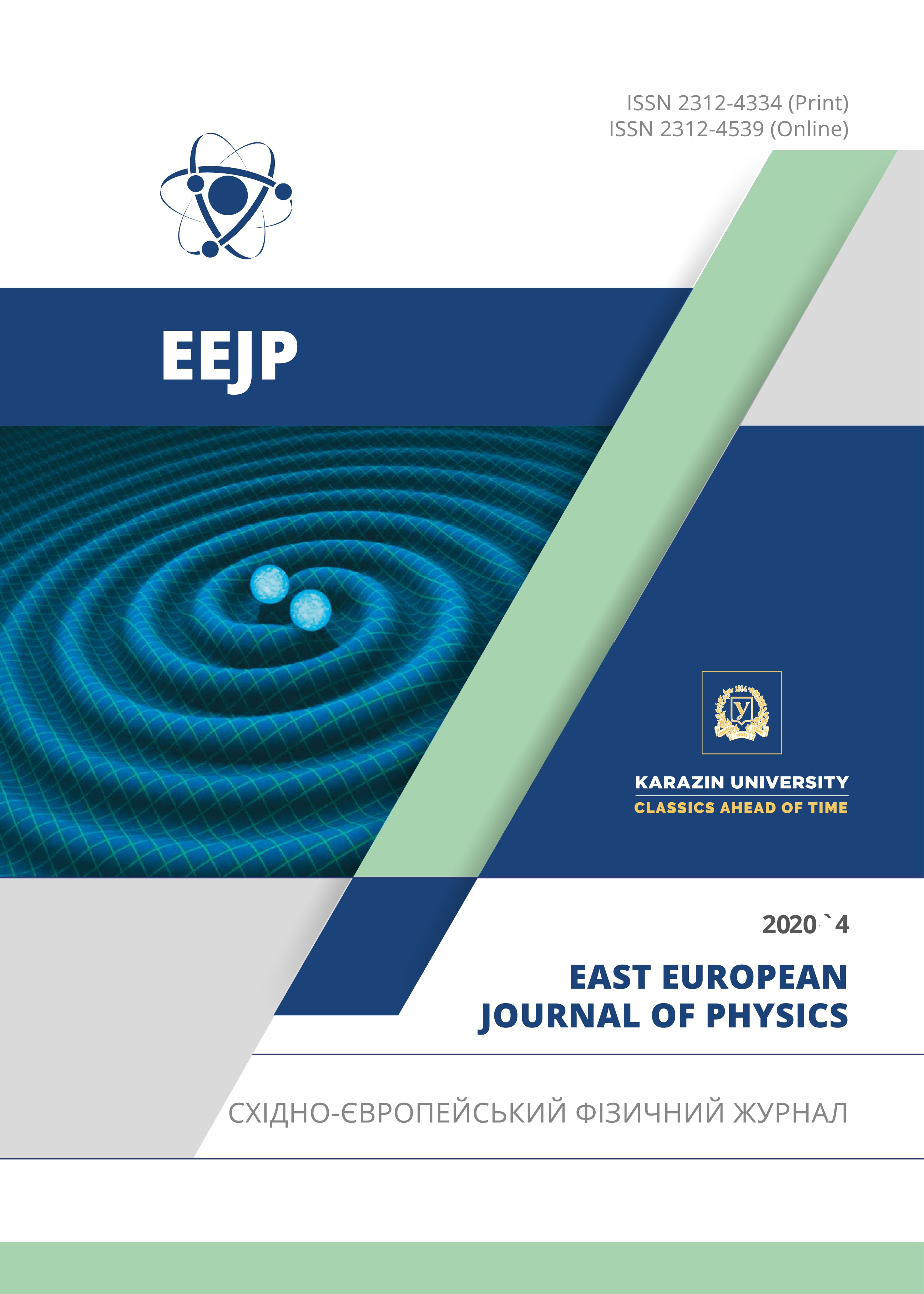Локалізація тепла в середовищі в режимі з загостренням
Анотація
Експериментально доведено існування ефекту метастабільної локалізації тепла в середовищі в режимі нагрівання з загостренням. Це режим, при якому густина енергії нагрівання за кінечий проміжок часу росте до нескінченності. Раніше теоретичні дослідження показали, що при цьому можуть створюватись області, температура всередині яких зростає, а розмір залишається постійним або зменшується з часом (області локалізації тепла). Області існують, доки відбувається надходження енергії ззовні. Створена установка для експериментального вивчення теплових режимів з загостренням в твердому тілі. Об'єктом дослідження був алюмінієвий стрижень з нагрівачем на торці. Температура торця стрижня могла змінюватися за заданим законом. Розподіл температури вздовж стрижня вимірювався термопарами. Проведена калібровка установки. Визначена чутливість термопар. Оцінена інерційність процесу нагрівання і охолодження. Зроблено математичний опис теплових процесів, які протікають при проведенні експерименту. Розв'язане нелінійне рівняння теплопровідності для стрижня з урахуванням теплообміну з навколишнім середовищем конвекцією і випромінюванням. Визначено тепловий режим на границі, необхідний для створення теплових структур. Проведені вимірювання розподілу температури в стрижні в режимах з загостренням і без загострення. У режимі з загостренням тепловий фронт (координата точки з температурою, в два рази меншою максимальної температури) спочатку поширюється в сторону від місця нагрівання, а потім починає рухатися у зворотний бік, і розмір нагрітої області зменшується. У режимі без загострення розмір нагрітої області весь час збільшується. Ефект передбачалося використовувати в установках для здійснення термоядерного синтезу при нагріванні мішені імпульсами лазерного випромінювання спеціальної форми. Ефект також може бути використаний для локального нагрівання при різанні і зварюванні, коли сусідні області не повинні сильно нагріватися, і інших подібих випадках.
Завантаження
Посилання
S.P. Kapitza, S.P. Kurdyumov, G.G. Malinetskiy, Синергетика и прогнозы будущего [Synergetics and Forecasts of the Future], (Nauka, Moscow, 2003), pp. 288. (in Russian)
S.P. Kapitza, in: World population growth as a scaling phenomenon and the population explosion. Climate change and energy policy, edited by L. Rosen, and R. Glasser. (AIP, New York, 1992), pp. 241-248.
S.P. Kapitza, World population growth. A world at the crossroads: new conflicts, new solutions, edited by J. Rotblat. (World Scientific, Singapore, 1994), pp. 198-217, https://doi.org/10.1142/9789814327008_0024.
A.A. Samarsky, N.V. Zmitrenko, S.P. Kurdyumov, and A.P. Mikhailov, Доклады Академии Наук СССР [Reports of the USSR Academy of Sciences]. 233(6), 1344 1347 (1975), http://www.mathnet.ru/links/0c91838b716a90926704d734c046bb31/dan39241.pdf. (in Russian).
S.P. Kurdyumov, Режимы с обострением [Peaking modes]. (Физматлит, Москва, 2006), pp. 238. (in Russian)
V.A. Kovalev, Сложные системы [Complex systems], 60(3), 50 (2015), pp. 50. (in Russian)
N.V. Zmitrenko, S.P. Kurdyumov, A.P. Mikhailov, and A.A. Samarskiy, Метастабильная локализация тепла в средах с нелинейной теплопроводностью и условия ее проявления в эксперименте [Metastable localization of heat in media with nonlinear heat conductivity and conditions for its manifestation in experiment], Preprint IPM AH SSSR, 103, 103 (1977), (in Russian)
V.A. Galaktionov, S.P. Kurdyumov, A.P. Mikhailov, and A.A. Samarskii, Действие граничных режимов с обострением на среду с постоянной теплопроводностью [Action of boundary regimes with sharpening on a medium with constant thermal conductivity], Preprint IPM AH SSSR, 28, 76 (1979), (in Russian)
E.N. Knyazeva, and S.P. Kurdyumov, Основания синергетики. Режимы с обострением, самоорганизация, темпомиры [Foundations of Synergetics. Regimes with aggravation, self-organization, tempomir], (Altateya, Sankt Petersburg, 2003), pp. 402. (in Russian)
S.S. Katsnelson, A.M. Orishich, and G.A. Pozdnyakov, Прикладная механика и техническая физика [Applied Mechanics and Technical Physics], 44(5), 23-29 (2003). (in Russian)
A. Zimmers, L. Aigouy, M. Mortier, A. Sharoni, S. Wang, K.G. West, J.G. Ramirez, and I.K. Schuller, Phys. Rev. Lett. 110, 056601 (2013), https://doi.org/10.1103/PhysRevLett.110.056601.
J.G. Ramirez, R. Schmidt, A. Sharoni, M.E. Gomez, I.K. Schuller, and E.J. Patino, Appl. Phys. Lett. 102, 063110 (2013), https://doi.org/10.1063/1.4792052.
J. del Valle, Y. Kalcheim, J. Trastoy, A. Charnukha, D.N. Basov, and I.K. Schuller, Phys. Rev. Appl. 8, 054041 (2017), https://doi.org/10.1103/PhysRevApplied.8.054041.
A.L. Rakhmanov, V.S. Vysotsky, and N.V. Zmitrenko, IEEE Trans. Appl. Supercond. 13, 1942-1945 (2003), https://doi.org/10.1109/TASC.2003.812971.
V. Vysotsky, A. Rakhmanov, and N. Zmitrenko, Thermal stability of Bi-2223 wires, in Research, Fabrication and Applications of Bi-2223 HTS Wires, World Scientific Series in Applications of Superconductivity and Related Phenomena Vol. 1 (World Scientific, Singapore, 2015), pp. 105-122.
V.I. Polozov, S.S. Maklakov, A.L. Rakhmanov, S.A. Maklakov, and V.N. Kisel, Phys. Rev. B, 101, 214310 (2020), https://doi.org/10.1103/PhysRevB.101.214310.
A. Misnar, Теплопроводность твердых тел, жидкостей, газов и их композиций [Thermal conductivity of solids, liquids, gases and their compositions]. (Mir, Moscow, 1968). pp. 464. (in Russian)
I.K. Kikoin, editor, Таблицы физических величин. Справочник [Tables of physical quantities. Handbook]. (Atomizdat, Moscow, Москва, 1976). pp. 1008. (in Russian)
A.V. Lykov, Теория теплопроводности [Heat conduction theory]. (Vysshchsya Shkola, Moscow, 1966). с. 600. (in Russian)
Авторське право (c) 2020 М.Г. Кокодій, С.В. Погорєлов

Цю роботу ліцензовано за Міжнародня ліцензія Creative Commons Attribution 4.0.
Автори, які публікуються у цьому журналі, погоджуються з наступними умовами:
- Автори залишають за собою право на авторство своєї роботи та передають журналу право першої публікації цієї роботи на умовах ліцензії Creative Commons Attribution License, котра дозволяє іншим особам вільно розповсюджувати опубліковану роботу з обов'язковим посиланням на авторів оригінальної роботи та першу публікацію роботи у цьому журналі.
- Автори мають право укладати самостійні додаткові угоди щодо неексклюзивного розповсюдження роботи у тому вигляді, в якому вона була опублікована цим журналом (наприклад, розміщувати роботу в електронному сховищі установи або публікувати у складі монографії), за умови збереження посилання на першу публікацію роботи у цьому журналі.
- Політика журналу дозволяє і заохочує розміщення авторами в мережі Інтернет (наприклад, у сховищах установ або на особистих веб-сайтах) рукопису роботи, як до подання цього рукопису до редакції, так і під час його редакційного опрацювання, оскільки це сприяє виникненню продуктивної наукової дискусії та позитивно позначається на оперативності та динаміці цитування опублікованої роботи (див. The Effect of Open Access).








